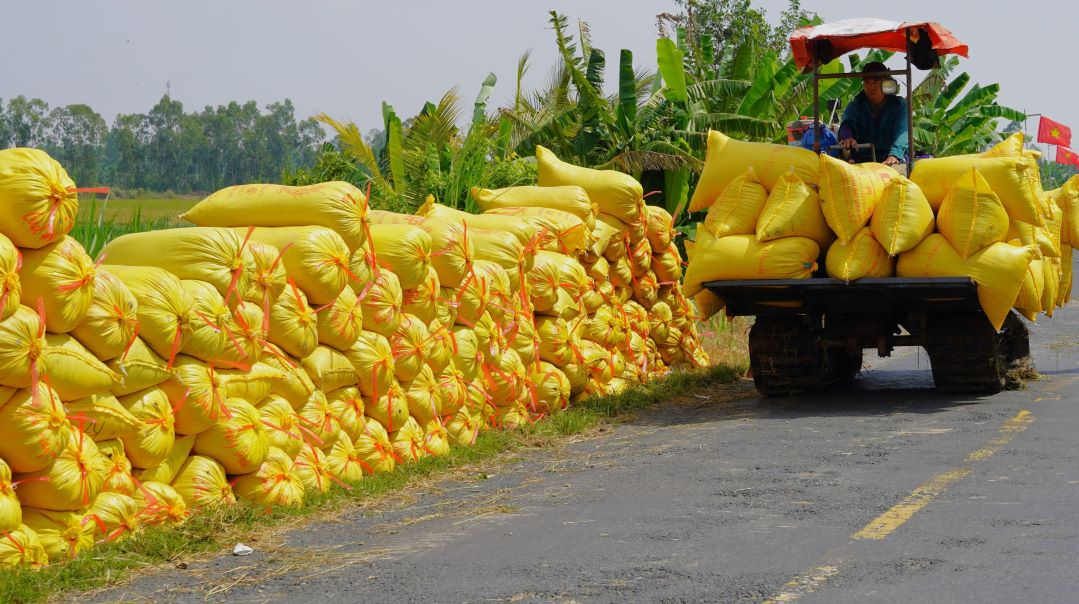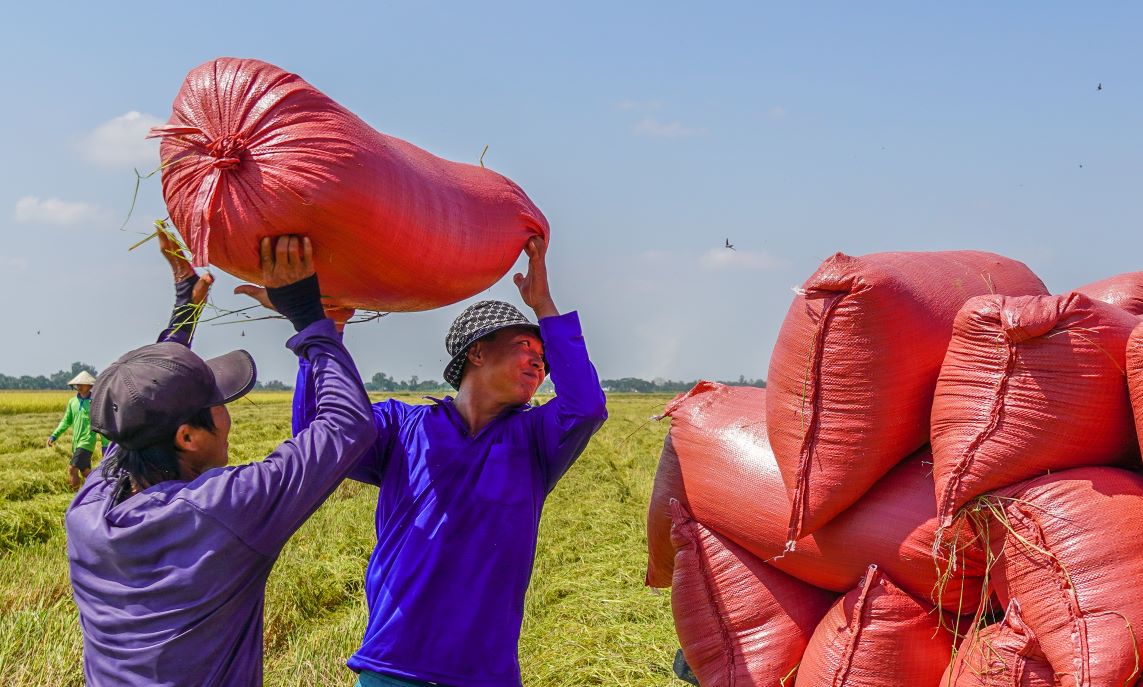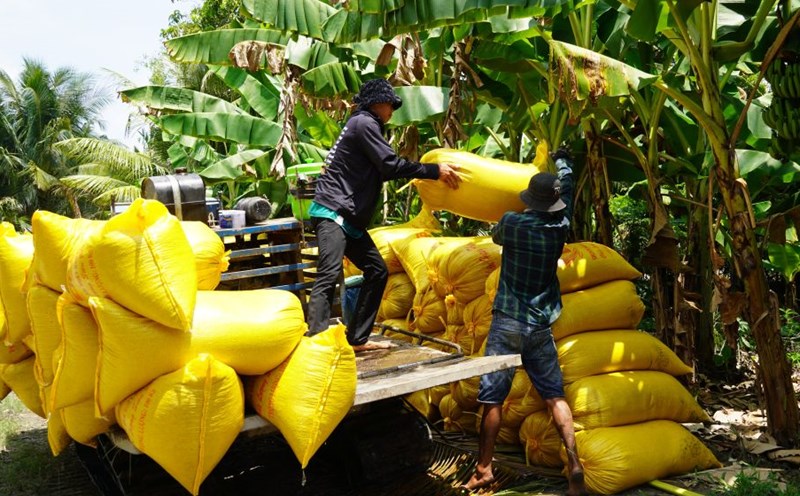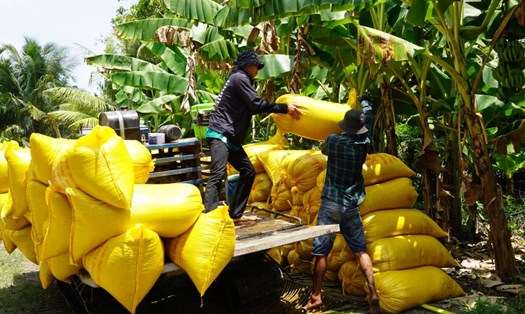Farmers reduce income
Mr. Nguyen Tin Thanh, residing in Thanh Trung hamlet, Trung Hung commune (Can Tho city) said that there are 5 hectares of rice, the recent Summer-Autumn crop yielded nearly 40 tons. At the beginning of the season, traders deposited VND6,200/kg, but when harvested, there was only VND5,000/kg left. After deducting production costs of about 150 million VND, his family only made a profit of 50 million VND, down 40 million compared to the same period last year.
"The rice price is low, so the profit has also decreased. Some households store rice waiting for prices to increase, but most have to sell immediately because of the rain, high drying costs and reduced rice quality, causing the selling price to not be as expected," Mr. Thanh shared.
Farmer Cao Hoang Chien in Dong Loi hamlet (Dong Thuan commune, Can Tho city) said that the price of OM 5451 rice is currently only 5,100 VND/kg, while last year's Autumn-Winter crop reached 7,000 VND/kg. "The rice is beautiful but the current price is being over budgeted because the production cost is high. If I do 3 crops/year, I will try my best but not make a profit. Maybe we have to reduce to 2 crops so that the land can rest and choose high-quality rice varieties to sell at higher prices," said Mr. Chien.

Mr. Tran Van Dat - Chairman of Trung Hung Commune People's Committee (Can Tho City) said that there are 18 rice businesses in the area, most of which are currently operating at a low level due to reduced revenue. The main reason is due to difficulties in exports and large inventories, making it impossible for traders and businesses to continue purchasing.
According to the Department of Industry and Trade of Can Tho City, since the beginning of the year, the city has exported more than 1.2 million tons of rice, reaching a turnover of nearly 600 million USD. Currently, there are 34 enterprises participating in rice production and export, mainly focusing on major markets such as the Philippines, Malaysia, South Africa, Australia, Singapore, China, Qatar, etc. However, exports in recent days have shown signs of slowing down.
Mr. Hua Truong Son - Deputy Director of the Department of Industry and Trade of Can Tho City said that the traditional market of Vietnamese rice in the Philippines has temporarily stopped importing for 60 days from September 1. Indonesia also temporarily suspended imports to prioritize the use of national reserve rice, which is also a natural thing, causing domestic rice prices to decrease.
Mechanism to protect rice prices
A rice enterprise in An Giang said that the Philippines' temporary suspension of rice imports for 2 months was expected to start in August, so Vietnamese and Philippine enterprises have taken advantage of the strong purchase before September 1. Currently, the Vietnamese rice warehouse in the Philippines is abundant. Vietnamese rice still has the advantage over Thailand and India thanks to its suitability for the taste of Philippine consumers and continuous supply.
According to this enterprise, currently in the Mekong Delta, the Summer-Autumn rice has been harvested, the early Winter-Spring rice output is not much and farmers can reserve a part, the Philippines' temporary suspension of rice imports does not affect farmers much. It is expected that by November, when the Philippines resumes import, the amount of rice in the fields will be limited, demand will increase, prices may increase, and people and businesses with goods will benefit.
In the long term, businesses propose to have a rice price insurance mechanism for farmers. When prices drop to a certain level, the State needs to activate the temporary storage and notification program so that people can be proactive in production and sales. "For example, the price of OM 18 rice has decreased below VND6,000/kg, a temporary storage program will be implemented to help farmers feel secure in production and avoid being forced to price by traders," said the representative of this enterprise.

The leader of the Department of Industry and Trade of Can Tho City said that the Department is actively coordinating with functional agencies to support businesses, in which it has directed the Import-Export Management Department to closely coordinate with Vietnamese trade associations, departments and trade promotion abroad to grasp market developments, thereby proposing solutions to support businesses.
In the long term, the Department encourages businesses and farmers to increase the value of rice grains, focus on building brands, gradually conquering demanding markets such as Japan to diversify output and improve the sustainability of the industry.
According to records, rice prices on September 12 in the Mekong Delta continue to maintain a stable price. Specifically, IR 50404 rice (fresh) is around 5,700 - 5,900 VND/kg; OM 5451 rice (fresh) is trading at 5,900 - 6,000 VND/kg; OM 18 rice (fresh), girl Hoa 9 is priced at 6,000 - 6,200 VND/kg; OM 380 rice (fresh) is around 5,700 - 5,900 VND/kg; Thom 8 (fresh) is fluctuating around 6,100 - 6,200 VND/kg.
Recorded in many localities today, traders are buying rice in moderation because the output is still slow, the price is relatively stable. In Dong Thap, there are few transactions of Autumn-Winter rice, with prices fluctuating slightly. In Can Tho, farmers offer high prices for Autumn-Winter rice but the number of transactions is limited. In An Giang, Autumn-Winter rice is traded everywhere, traders ask to buy less. In Vinh Long, the price of fresh rice of all kinds is stable, making transactions more favorable. In Ca Mau, traders buying new Autumn-Winter rice are scattered, the price remains stable. In Tay Ninh (under the old Long An), rice trading is also slow, with prices fluctuating little.








